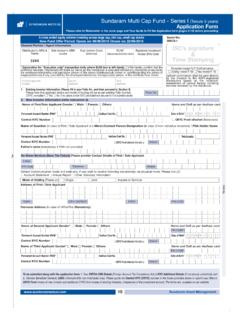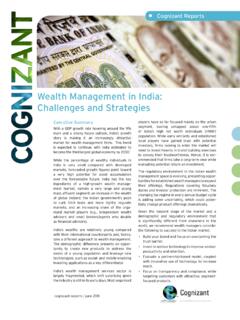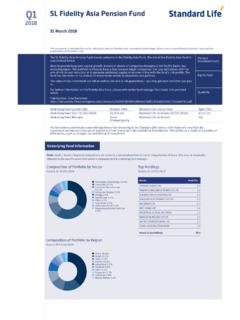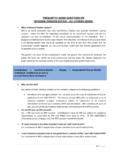Transcription of A Review on Solvency Margin in Indian Insurance …
1 43 International Journal of Recent Research and Review , Vol. II, June 2012 ISSN 2277 8322 A Review on Solvency Margin in Indian Insurance companies Bhuvnesh Gour1, Gupta2 1 Asst. Prof., Deptt of ABST, PCGE, Jaipur, India 2 Asst. Prof., Deptt of ABST, University of Rajasthan, Jaipur, India Email: Abstract - Every company has assets and liabilities. In any crisis company used their assets to pay off their liabilities. When company has equal assets and liabilities then company easily pay their liabilities from their assets. But when the liability increases unexpectedly In that case company will be declared insolvent. This will be a bed situation. That s the reason, Solvency Margin comes into picture. In this context, the present paper analyze the Solvency ratio of five life Insurance companies of India for the period of three years from 2009-2010 to 2011-12.
2 The paper also attempts to investigate whether the Performance of different companies is similar to each other or is there any significant difference in that. It further assigns ranks to different companies on the basis of their Solvency ratio. Keywords - Solvency Ratio, Required Solvency Margin , Available Solvency Margin , Capacity of paying their liabilities I. INTRODUCTION The term ` Solvency Margin ' came into vogue in the 1970s, in Europe. Till then, the only requirement to be satisfied by a life Insurance company was that, after the distribution of surplus, if any, the value of its assets should not be less than the value of its liabilities. Instead, it was stipulated that the value of assets should exceed the value of liabilities by a certain Margin .
3 This Margin was known as the Solvency Margin . No mathematical technique has so far been developed to determine the quantum of Margin required. The European Union developed an empirical formula based on past experience and the same has now been adopted in India, with some modifications [1]. The Solvency of an Insurance company corresponds to its ability to pay claims. The Solvency ratio is a way investors can measure the company s ability to meet its long term obligations An insurer is insolvent if its assets are not adequate [over indebtedness] or cannot be disposed of in time to pay the claims arising. In other words, it is the extra capital that an Insurance company is required to hold. As per the IRDA (Assets, Liabilities, and Solvency Margin of Insurers) Rules 2000, both life and general Insurance companies need to maintain Solvency margins.
4 Life Insurance companies are expected to maintain a 150% Solvency Margin . The higher the ratio is the better equipped a company is to pay off its debts and survive in the long term. All Insurance companies have to pay claims to policy holders. These could be current or future claims of policy holders. Insurers are expected to put aside a certain sum to cover these liabilities. These are also referred to as technical provisions. Insurance , however, is risky business and unforeseen events might occur sometimes, resulting in higher claims not anticipated earlier. For instance, calamities like the Mumbai floods, J&K earthquake, fire, accidents of a large magnitude, etc may impose an unbearable burden on the insurer. In such circumstances, technical provisions though initially prudent, may prove insufficient for taking care of liabilities.
5 If the liability is large, there is a possibility of the Insurance company becoming insolvent. This would create an awkward situation for the Insurance sector, regulator and also the government. The Solvency Margin is thus aimed at averting such a crisis. The purpose of the extra capital 44 all insurers are required to keep as per the regulatory norms is to protect policy holders against unforeseen events. The Solvency Margin is designed to take care of problems that are usually not anticipated. It also provides elbow room to the managers of insurers to rectify problems and take precautionary measures. However, whether an Insurance company fails also depends upon the magnitude of the crisis. Ordinarily, an Insurance company with the requisite Solvency Margin is not likely to fail.
6 However, Insurance Business is risky in nature and there can be no absolute guarantee. Events such as the terrorist attack on the World Trade Centre in New York can create unexpected liabilities of intense difficulty to anticipate and cover. Liabilities can also increase manifold as a result of fraud by employees. No Insurance regulator or company can completely guard against fraud, Solvency Margin norms notwithstanding. However, such occurrences are rare. Insurance failure in the past two decades has been very rare. According to section 64 VA of the Insurance Act, 1938 every insurer required to maintain a Required Solvency Margin (RSM). This Required Solvency Margin cannot be less than an amount prescribed by the IRDA [2]. II. DETERMINATION OF Solvency RATIO OF LIFE INSURERS " Solvency Ratio" means the ratio of the amount of Available Solvency Margin to the amount or Required Solvency Margin .
7 Solvency Ratio = Available Solvency Margin Required Solvency Margin (a) "Available Solvency Margin " means the excess of value of assets (furnished in IRDA-Form-AA) over the value of life Insurance liabilities (furnished in Form H as specified in Regulation 4 of Insurance Regulatory and Development Authority (Actuarial Report and Abstract) Regulations, 2000) and other liabilities of policyholders' fund and shareholders' funds. (b) The Required Solvency Margin is based on mathematical reserves and sum at risk, and the assets of the policyholders fund. The numerator of the ratio represents the items such as (i) Capital or funds (ii) Various reserve that include price fluctuation reserve (iii) A portion of unrealized profits obtained from real estate and stocks The above characteristics call on the insurers to follow certain basic principles of asset management: (i) Safety: As a minimum fund value should not erode.
8 (ii) Profitability: Returns on investment must exceed cost of liabilities. (iii) Liquidity: Ready for payment of claims and surrenders. The denominator of the ratio belongs to the risks like: (i) Underwriting Risks: Risk of miscalculating premiums and miscalculate technical provisions. (ii) Risks on the expected interest rated: It is considered to be an important factor contributing to the insolvency of an Insurance company. (iii) Risks related to asset management : Growth risk arising out of exercise growth not matched by sufficient resources of due to wrong selection or wrong pricing of products. Life insurers follow one or more of the following assets liability management methods for healthy asset liability ratio: (i) Cash flow testing: The actuary tests the cash flow of the Insurance company under various interest rate scenarios.
9 (ii) Cash flow matching: A block of liabilities with identified cash flow would be matched with a block of assets with identical cash flow. (iii) Immunization: Duration of the liability portfolio is estimated and matched with and asset portfolio of identical duration. Insurance Regulatory and Development Authority has prescribed methods of valuation of assets and liabilities of Life Insurance [3]. 45 III. MINIMUM REQUIRED Solvency Margin OF LIFE INSURER In the case of an insurer carrying on life Insurance business, the required Solvency Margin shall be the higher of rupees five hundred million (one billion in case of re-insurers) or the aggregate sum arrived at based on a formula given in the Insurance Act/ Regulation. The Life Insurance companies may have to inject additional capital to maintain the minimum required Solvency Margin as per the regulatory requirements.
10 IRDA has set a minimum Solvency Ratio (Ratio of Actual Solvency Margin to the Required Solvency Margin ) of for all life insurers. Every life insurer is required under the IRDA (Assets, Liabilities and Solvency Margin of Insurers) Regulations, 2000, to prepare a statement of Solvency Margin in accordance with Schedule III-A [4]. From 2007-08, life insurers must be presented their Solvency Status in enclosed statement (From KT-Q) on quarterly (June 30, September 30, December 31 and March 31) basis every year [5]. The details of Annexure I are as follows: 1. Item No. 01 shall be the amount of the total Adjusted Value of Assets in respect of policyholders' funds as mentioned in Form IRDA-Assets-AA. 2. Item No. 02 shall be the amount of Total Liabilities as mentioned in Form HG.



